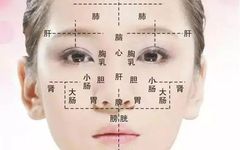Patient’s question: “As soon as we met, you said I have spleen deficiency and excessive dampness, and you even mentioned some of my physical discomforts. How does Traditional Chinese Medicine (TCM) work so magically? What is the basis of your judgment?”
The “Nanjing” states: “To know by observation is called divine.” This emphasizes the importance of observation in the diagnosis and treatment of diseases in TCM. The “Danxi Heart Method” states: “What is within must manifest without.” Through observation, TCM can discern the internal state of the body. Next, I will briefly introduce how to assess health through facial observation.
Facial Diagnosis
The face is a holographic reflection of all parts of the body and diseases, from the five internal organs to the limbs and skin, all are interconnected. Each area of the face represents or reflects the corresponding internal organ’s condition.

Head and face: Center of the forehead. Indications: Head and facial diseases, brain diseases.
Lungs: Midpoint between the eyebrows. Indications: Cough, asthma, and other respiratory diseases.
Throat: Midpoint between the head and lungs. Indications: Pharyngitis, plum pit qi, etc.
Liver: Midpoint connecting the heart and spleen areas. Indications: Liver diseases and pain in the flanks.
Heart: Located at the lowest point of the nasal bridge. Indications: Palpitations, insomnia, etc.
Spleen: Located at the tip of the nose. Indications: Poor appetite, abdominal distension, indigestion, etc.
Gallbladder: On both sides of the liver area. Indications: Cholecystitis, gallstones, etc.
Bladder: Corresponds to the location of the water ditch point. Indications: Lower back pain.
Stomach: Located on both sides of the spleen. Indications: Stomach pain, vomiting.
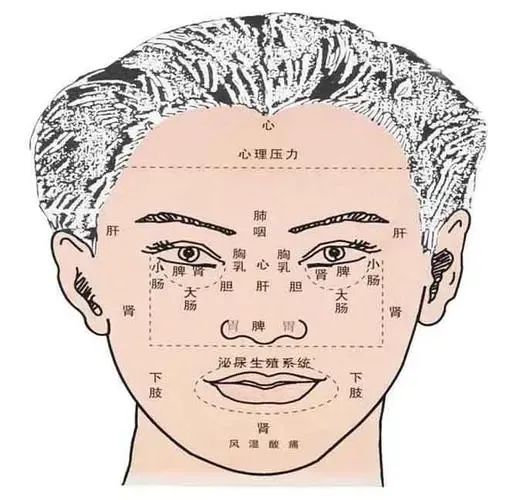
Large Intestine: Below the cheekbone. Indications: Constipation, abdominal pain, diarrhea, etc.
Uterus: Overlapping with the bladder area. Indications: Dysmenorrhea, pain in the genital area.
Kidney: Intersection of the horizontal line of the nostrils and the vertical line of the temples. Indications: Enuresis, etc.
Small Intestine: Located on the inner side of the cheekbone. Indications: Diarrhea.
Chest (Breasts): Just above the inner canthus of the eye. Indications: Chest fullness, chest tightness, etc.
Umbilicus: Slightly below the kidney area. Indications: Periumbilical pain.

TCM believes that the five internal organs are connected to the face through meridians, and the qi and blood of the organs nourish the face. Changes in the face can reflect the conditions of the internal organs and the changes in qi and blood. Since the face is the easiest area to gather information during observation, facial diagnosis is crucial, especially observing facial color.
First, we need to understand what a normal facial color is. A normal facial color should be a subtle red-yellow, bright and moist. TCM believes that the five colors—green, red, yellow, white, and black—differ from the normal facial color and can reflect abnormal changes within the body.
1. Green Color
A greenish complexion resembles the color of “green grass.” TCM associates green with cold syndromes, qi stagnation, blood stasis, pain, and wind stroke. When the liver is problematic, the face often appears green.
Typical cases:
(1) A young man came to me due to discomfort. I observed his face was green, and he seemed depressed. I asked if he had been staying up late or was angry recently. He admitted to feeling anxious and angry these days and had insomnia for several nights. This is an example of a green complexion caused by liver qi stagnation due to staying up late.
(2) A child with a high fever showed signs of impending wind stroke—greenish color around the root of the nose and lips. I once treated a child with a high fever and convulsions, and I noticed the root of the nose and the area around the lips were distinctly green. In TCM, high fever convulsions are called “acute wind stroke,” and the greenish color around the nose and lips in a child with a high fever is a warning sign of impending “wind stroke.”
2. Red Color
A reddish complexion resembles the color of a “rooster’s comb.” TCM associates red with heat syndromes. When the heart is problematic, the face often appears red. However, heat syndromes can be divided into excess and deficiency; excess heat should be treated with heat-clearing and fire-purging methods, while deficiency heat should be treated with nourishing yin and lowering fire, and one should not blindly use cold herbs to reduce heat.
Typical cases:
(1) A patient with hypertension had a notably red face, especially on the forehead and cheeks, and his neck was also red. He spoke with difficulty, coughed up yellow phlegm, had constipation, and his tongue was red with a yellow greasy coating. The redness on the forehead was due to yangming heat, with gastrointestinal blockage causing the heat to rise; the redness on the cheeks was a reaction to liver fire disturbance. Therefore, after differential diagnosis and treatment, the redness disappeared, and his blood pressure returned to normal.
(2) A young man with a floating red complexion felt very hot, easily sweating small beads on his head, but his hands and abdomen felt cool to the touch. He craved hot drinks and felt fatigued. His tongue was pale with a white coating. This was due to deficiency of yang qi, with excess yin internally, causing the deficiency yang to rise.
3. Yellow Color
Its color resembles “yellow earth.” TCM states that “yellow represents the spleen,” indicating spleen deficiency and dampness, often due to spleen deficiency leading to failure in transporting qi and blood to nourish the face; or dampness accumulating internally, causing the spleen to fail in its transformation and transportation, resulting in a yellowish complexion.
Typical cases:
(1) A patient with diarrhea experienced a yellowish complexion due to spleen deficiency. He reported that he had diarrhea every time he ate, with loose stools that had no odor, felt fatigued, lacked appetite, and experienced dizziness and palpitations. This is a typical manifestation of spleen deficiency.
(2) A female patient with anemia had a blood test showing anemia, often experienced numbness in her hands and feet, had a small menstrual flow, and frequently lacked appetite. Her complexion was yellowish, and her nails were pale. This is a typical manifestation of blood deficiency, which, if it progresses, can lead to a pale complexion.
4. White Color
TCM associates white with deficiency syndromes, cold syndromes, blood loss, and qi deficiency. If qi and blood are deficient, or if there is blood loss or qi deficiency, it can lead to insufficient nourishment to the face; cold can cause qi to stagnate, leading to reduced blood flow; and weak yang qi can result in decreased blood supply to the face. These factors can all lead to a pale complexion.
Typical case: A female patient presented with a pale complexion, shortness of breath, fatigue, and cold hands and feet without any obvious reason for half a month. This is a manifestation of qi and blood deficiency. Subsequent blood tests confirmed anemia.
5. Black Color
A blackish complexion resembles the color of “deep water,” a bluish-black color. If black appears, it indicates that there is excessive moisture in the body, referring to waste water or dampness, not normal body fluids. Patients with kidney deficiency often show a blackish complexion. Additionally, black is associated with cold syndromes, pain syndromes, and blood stasis. Of course, a person’s natural skin color, which remains unchanged throughout life, is not considered an abnormal complexion, such as individuals with naturally dark skin.
TCM believes that different areas of the face correspond to different internal organs, and abnormalities in a specific area indicate corresponding issues.
The “Suwen: Discussion on Needle Heat” uses the face to observe the five internal organs (Figure 1). Clinically, patients with liver heat disease often show redness on the left cheek first; patients with heart heat disease often show redness on the forehead first.
Once, a patient asked why he had persistent acne on his chin. This is often caused by kidney deficiency and excessive fire, and his complexion was also flushed. After appropriate TCM treatment, he quickly recovered.
Moreover, the five facial features correspond to specific organs, and diseases of the features can reflect changes in the internal organs. For example, sores on the nose, commonly known as “rosacea,” often belong to lung and stomach heat accumulation.
Of course, the above explanation is just a small part of facial observation and only provides a preliminary impression of diseases. The final diagnosis still requires a comprehensive assessment through the four examinations to accurately determine the condition.
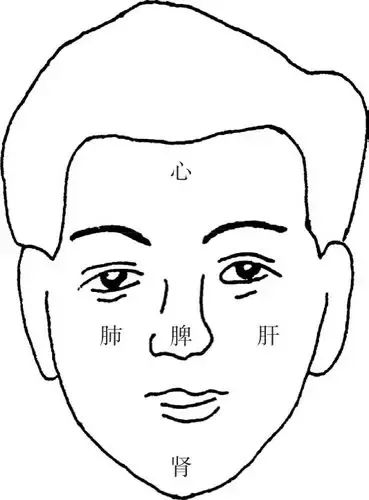
1. Facial Color
Cheeks red and hot—abnormal body temperature regulation.
Cheeks pale—insufficient oxygen supply in the body.
2. Skin Condition
Wrinkles on the cheekbones—primarily caused by ultraviolet rays.
Acne on the cheeks—pay attention to diet, whether excessive or constipated.
Enlarged pores on the cheeks—reduced sebum is the main cause of enlarged pores.
Eye Diagnosis
The Eight Trigrams Theory: This divides the eye into different positions according to the eight trigrams, corresponding to the six internal organs, pericardium, and life gate. When the eyes are diseased, observation of position, color, thickness, and quantity can provide a basis for treatment.
The Five Wheels Theory: Based on the five elements, the eye is divided into five parts: inner wheel, blood wheel, qi wheel, wind wheel, and water wheel, each corresponding to specific internal organs, explaining the physiological and pathological mechanisms of the eye, guiding clinical diagnosis and treatment.
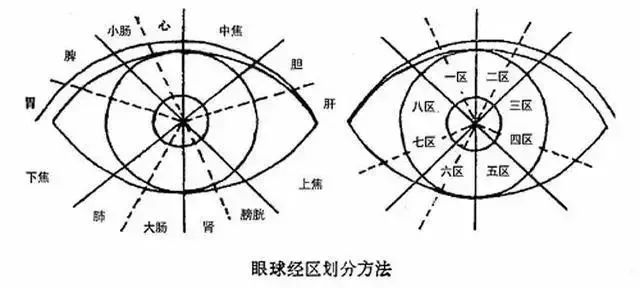
1. Symptoms around the eyes
Swollen eyelids—reduced function of internal organs (kidneys, gastrointestinal, heart) leading to water retention.
Dark circles—when blood contains excessive waste, it can cause the area around the eyes to darken (kidneys).
Wrinkles below the eyes—one of the signs of aging.
Sunken eye sockets—excessive consumption of body energy.
Inner eyelids turning white—symptom of anemia.
Yellowish-white small bumps on the eyelids—high cholesterol.
2. Eye Conditions
Yellowing of the sclera—warning sign of liver and gallbladder issues (jaundice).
Blood vessels in the sclera—indicates excessive tension in the liver, causing blood vessels to dilate.
Eye twitching—warning sign of weakened immunity.
3. Functional Disorders of the Eyes
Inability to fully close eyes during sleep—gastrointestinal issues leading to muscle weakness throughout the body.
Eyes easily fatigued—indicates liver dysfunction.
4. Eye Secretions
“Eye discharge”—yellow discharge indicates “pus” (inflammation).
Dry eyes—can easily lead to eye diseases.
Excessive tearing—occurs when liver function is weakened.
Ear Diagnosis
Holographic ear therapy is based on TCM meridian theory, developed from acupuncture. By using ear acupoints for magnetic moxibustion, it can fundamentally regulate the qi and blood flow of the internal organs, unblock blood vessels, and achieve the goal of treating the root cause of diseases.
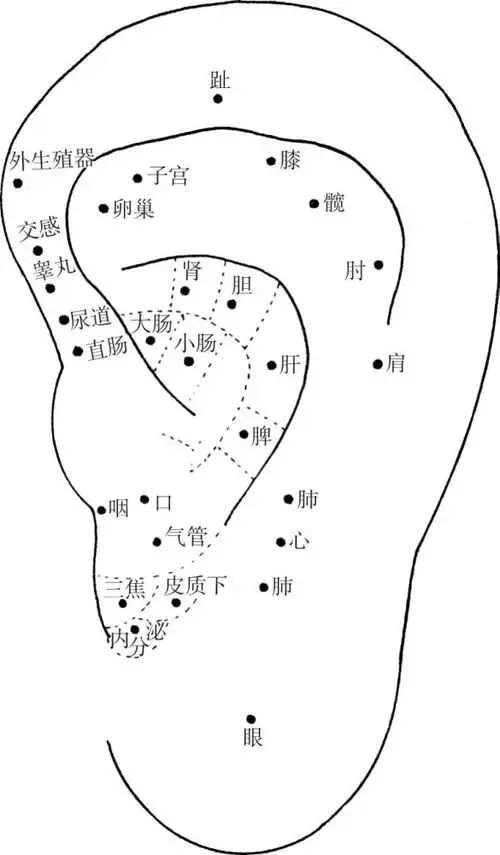
Nasal Diagnosis
The nose is a reflection of the internal organ systems, with specific corresponding areas for each organ. These areas systematically reflect the physiological and pathological conditions of the internal organs.
1. Condition of the Nose
Size of the nose—strength of respiratory function.
Nostrils flaring—indicates difficulty in breathing.
2. Skin Condition of the Nose
Acne on the nose—may indicate respiratory issues.
Redness at the tip of the nose—signal of excessive alcohol consumption.
3. Nasal Secretions
The nose can indicate body temperature—treatment of colds varies based on the type of nasal discharge.
Nasal congestion—if left untreated, it can lead to systemic hypoxia.
Frequent nosebleeds—often caused by gastrointestinal weakness.
Tongue Diagnosis
Tongue diagnosis is an important method in TCM for diagnosing diseases, as the tongue is connected to the five internal organs through meridians. Therefore, tongue diagnosis can reveal the deficiency or excess of the internal organs and the nature, severity, and changes of pathogenic factors.

1. Shape of the Tongue
Jagged edges on the tongue—swelling caused by excess water.
Cracked tongue surface—indicates insufficient moisture.
2. Movement of the Tongue
Slanted tongue—signal of cerebrovascular obstruction.
Trembling tongue—indicates body weakness.
3. Color of the Tongue
Red tongue body—indicates elevated body temperature.
Pale tongue body—indicates body weakness.
Purple tongue—signal of thick blood.
Varicose veins on the tongue—danger signal of poor blood flow.
4. Size of the Tongue
Large and thick tongue—indicates excess water in the body.
Small and thin tongue—indicates insufficient water in the body.
5. Thickness of the Tongue Coating
Thick coating, almost obscuring the tongue surface—indicates gastrointestinal disorders or serious diseases.
Thin coating, almost invisible—indicates body weakness or allergic constitution.
6. Color of the Tongue Coating
White coating—indicates low body temperature and reduced body function.
Yellow coating—indicates internal “heat”.
Black coating—indicates extreme physical exhaustion.
Lip Diagnosis
The lips are the hub of the fourteen meridians, the key points of the internal organs, and we use the Eight Trigrams diagram to illustrate the correspondence between the internal organs and the lips.
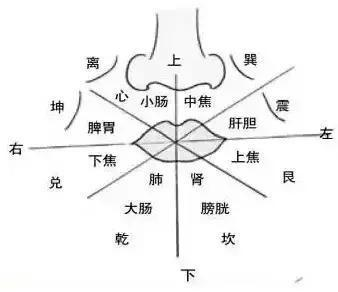
1. Around the Mouth
Cracked corners of the mouth—indicates gastritis causing false appetite.
Acne around the corners of the mouth—indicates weak gastrointestinal function.
Dry lips—elevated body temperature can cause dry lips.
Overly pale lips—warning sign of insufficient blood.
Overly red lips—indicates excessive internal heat accumulation.
2. Oral Symptoms and Secretions
Oral inflammation—evidence of lowered immunity.
Bad breath—can have five causes (active gastritis, indigestion, rhinitis, gum disease, dental plaque).
Feeling dry mouth and sticky saliva—indicates overall body dehydration.
Finding a pool of saliva by the pillow in the morning—indicates gastrointestinal weakness.
Dental Diagnosis
TCM believes that “teeth are the surplus of bones,” and “gums are the network of the stomach.” Teeth are closely connected to the internal organs through various meridians.
1. Condition of the Teeth
Prone to cavities—early sign of osteoporosis.
Gray teeth—indicates the formation of cavities inside the teeth.
2. Condition of the Gums
Swollen gums—indicates gastritis or fatigue.
Bleeding gums—indicates gum inflammation or gastrointestinal weakness.
Hair:
1. Hair Quality
Thinning hair—indicates a tendency towards anemia or aging.
Juvenile baldness—excessive fat intake can lead to hair depletion (reproductive organ decline).
Excessive hair loss—can indicate early signs of disease.
Premature graying—related to calcium and hair.
Curly hair—indicates thinning hair quality.
Excessive splitting and breaking—can be caused by anemia during menstruation.
2. Scalp Condition
Excessive dandruff—can be classified into “dry” (requiring iron and protein) and “oily” (requiring improved fat metabolism and vitamin B supplementation).
Soft and lacking elasticity scalp—indicates symptoms of edema.
Nails:
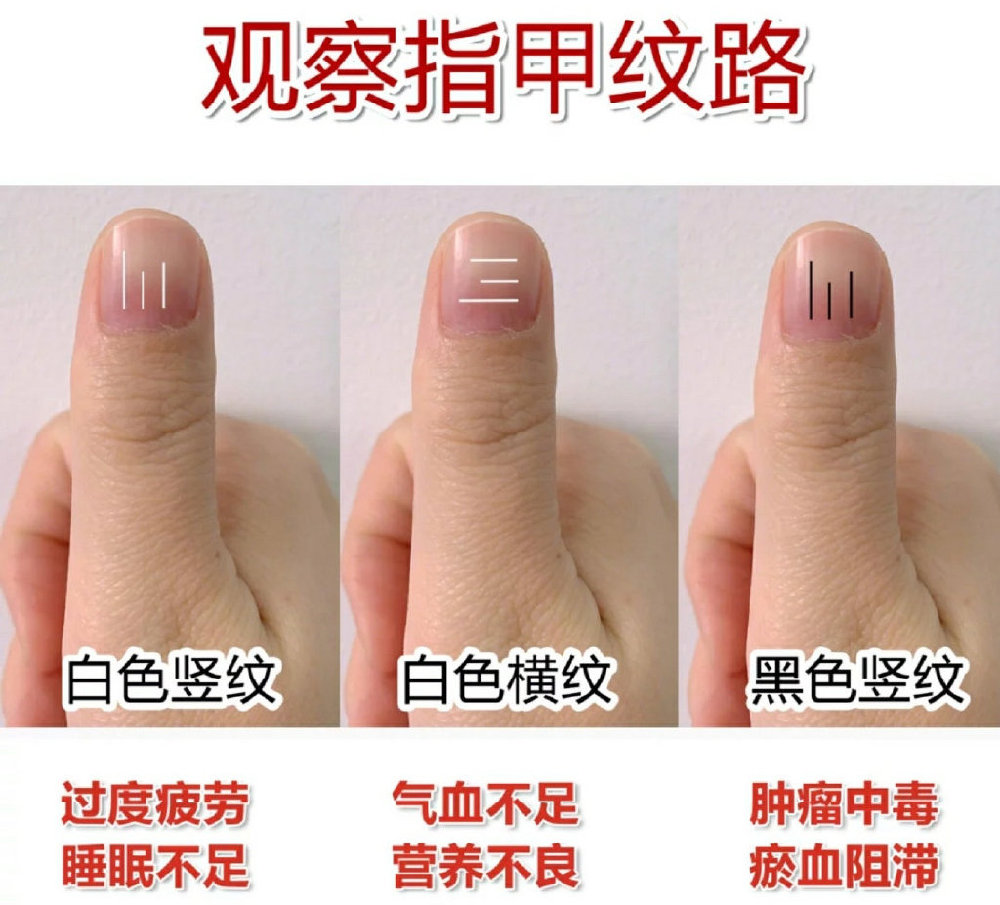
1. Nail Shape
Longitudinal cracks in the nails—”wrinkles” formed by aging.
Horizontal cracks in the nails—indicate “past” (body discomfort) records.
Prone to breakage—indicates anemia or poor liver function.
Spoon nails—body’s distress signal (severe anemia, uterine fibroids, endometriosis; detailed examination recommended).
Clubbing nails (bulging forward) are often seen in individuals with heart disease.
Disappearance of the white crescent at the base of the nails—indicates physical decline.
Mica nails—indicate dry nails.
2. Nail Color
Red nails—indicate thick blood (pay attention to cardiovascular health).
Purple-black nails—indicate turbid blood or poor heart function.
White nails—indicate a tendency towards anemia.
It is important to understand that the body and mind have their own rhythms and rules, which reflect the coordination and unity between humans and nature. If we do not allocate time for rest and health, we will inevitably create time for illness; if we do not allocate time for mental peace, we will create time for worry. Take a moment to pause, calm your restless mind, and ask yourself daily: What is the most precious thing? What is the most meaningful thing? Cherish and nurture the most precious things, and use your limited time and energy to do the most meaningful things!

